NUR5204: Education Program Development for ECG Interpretation
VerifiedAdded on 2022/10/01
|17
|4996
|478
Project
AI Summary
This project outlines an education program developed for teaching the basics of 12-lead ECG procedures and interpretation, addressing identified educational needs. The program utilizes professional nursing skills, standards, and educational knowledge to provide quality education, focusing on engaging learners to improve their understanding and performance. It incorporates active learning methods to enhance student engagement, knowledge retention, and practical skill application. The program includes a teaching philosophy based on active learning, specific goals and objectives, detailed teaching plans for three sessions, and an evaluation strategy based on Gibb's Model. Key components covered are the introduction to 12-lead ECG, electrode placement, and interpretation, with corresponding teacher and learner activities designed to achieve the program's learning objectives.

Running head: EDUCATION PROGRAM DEVELOPMENT 1
EDUCATION PROGRAM DEVELOPMENT.
(Author’s name)
(Institutional Affiliation)
EDUCATION PROGRAM DEVELOPMENT.
(Author’s name)
(Institutional Affiliation)
Paraphrase This Document
Need a fresh take? Get an instant paraphrase of this document with our AI Paraphraser

EDUCATION PROGRAM DEVELOPMENT 2
Introduction and Scene Setting.
This is a nursing education program developed specifically for the purpose of teaching
students on the basics 12 leads of ECG procedures and interpretations based on the needs gaps
identified on education needs assessment(ENA). This program will utilize professional nursing
skills, standards, and educational knowledge necessary for the provision of quality education to
the target students. Various gaps and needs to be required for furthering the understanding of the
12 leads ECG interpretation will be addressed during the teaching sessions. In this regard, an
educational program developed with a major aim of engaging learners in the teaching sessions to
maximize and improve their performances. This will, therefore, increase students' academic and
career development. This teaching program is meant to be done at teaching classrooms where all
the teacher and learners' activities will be integrated to achieve the set objectives. This teaching
program will cover the teaching philosophy, goals and objectives of the program, teaching plans,
evaluation and reflection based on Gibb’s Model.
Explanation and definition of key terms.
About ECG
An ECG is a recording of the heart's electrical activities over a period of time. The
electrical activities are usually detected by various electrodes placed on the surface of the human
skin but displayed on an external monitor(Francis, 2016). Changes in the electrical activities are
highly beneficial as they can indicate whether the patient has an arrhythmia, electrical
imbalances or cardiac ischemia.
12 Leads ECG System.
A 12 leads ECG system is divided into three parts which include bipolar with 3 limb
leads, unipolar with three augmented limb leads and six precordial leads(Francis, 2016). The
Introduction and Scene Setting.
This is a nursing education program developed specifically for the purpose of teaching
students on the basics 12 leads of ECG procedures and interpretations based on the needs gaps
identified on education needs assessment(ENA). This program will utilize professional nursing
skills, standards, and educational knowledge necessary for the provision of quality education to
the target students. Various gaps and needs to be required for furthering the understanding of the
12 leads ECG interpretation will be addressed during the teaching sessions. In this regard, an
educational program developed with a major aim of engaging learners in the teaching sessions to
maximize and improve their performances. This will, therefore, increase students' academic and
career development. This teaching program is meant to be done at teaching classrooms where all
the teacher and learners' activities will be integrated to achieve the set objectives. This teaching
program will cover the teaching philosophy, goals and objectives of the program, teaching plans,
evaluation and reflection based on Gibb’s Model.
Explanation and definition of key terms.
About ECG
An ECG is a recording of the heart's electrical activities over a period of time. The
electrical activities are usually detected by various electrodes placed on the surface of the human
skin but displayed on an external monitor(Francis, 2016). Changes in the electrical activities are
highly beneficial as they can indicate whether the patient has an arrhythmia, electrical
imbalances or cardiac ischemia.
12 Leads ECG System.
A 12 leads ECG system is divided into three parts which include bipolar with 3 limb
leads, unipolar with three augmented limb leads and six precordial leads(Francis, 2016). The
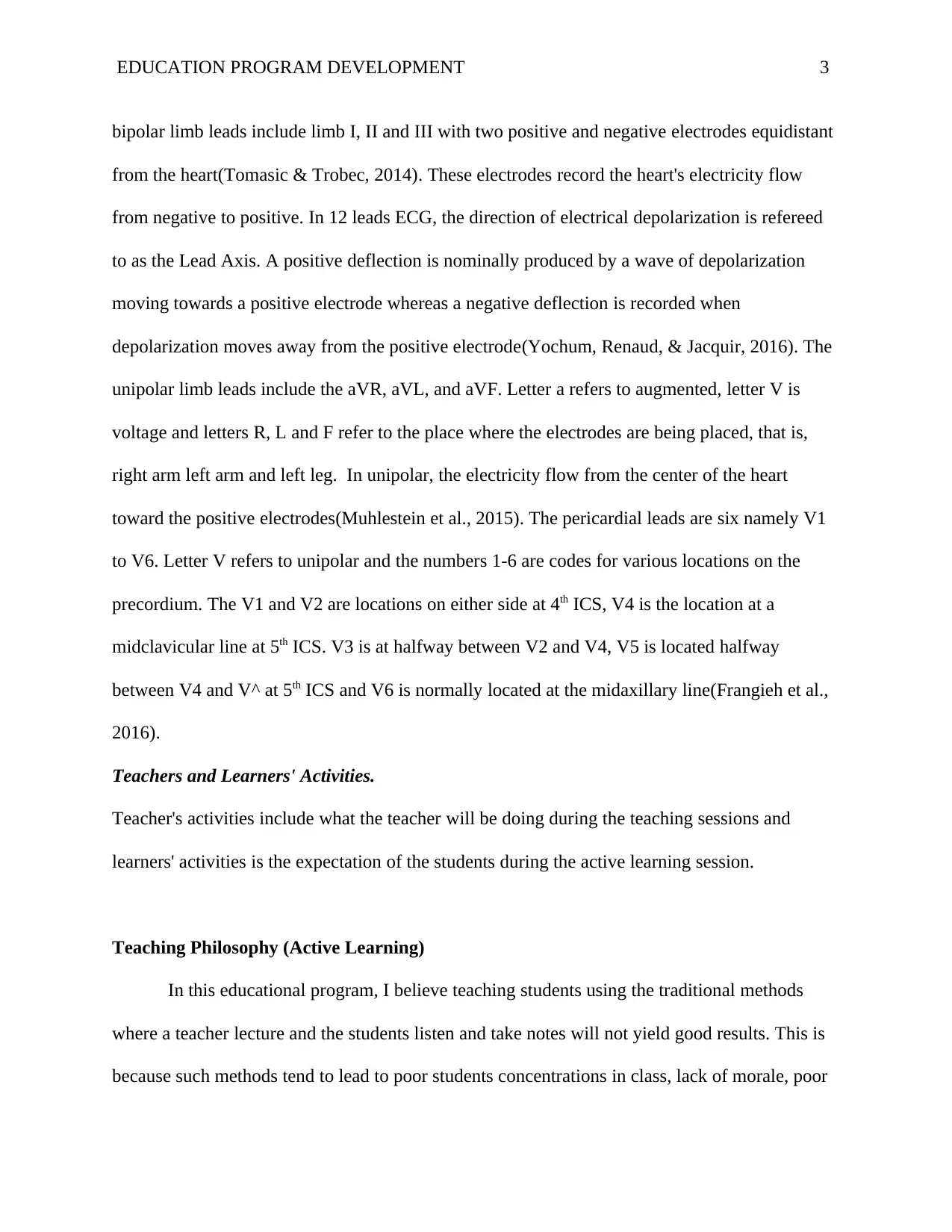
EDUCATION PROGRAM DEVELOPMENT 3
bipolar limb leads include limb I, II and III with two positive and negative electrodes equidistant
from the heart(Tomasic & Trobec, 2014). These electrodes record the heart's electricity flow
from negative to positive. In 12 leads ECG, the direction of electrical depolarization is refereed
to as the Lead Axis. A positive deflection is nominally produced by a wave of depolarization
moving towards a positive electrode whereas a negative deflection is recorded when
depolarization moves away from the positive electrode(Yochum, Renaud, & Jacquir, 2016). The
unipolar limb leads include the aVR, aVL, and aVF. Letter a refers to augmented, letter V is
voltage and letters R, L and F refer to the place where the electrodes are being placed, that is,
right arm left arm and left leg. In unipolar, the electricity flow from the center of the heart
toward the positive electrodes(Muhlestein et al., 2015). The pericardial leads are six namely V1
to V6. Letter V refers to unipolar and the numbers 1-6 are codes for various locations on the
precordium. The V1 and V2 are locations on either side at 4th ICS, V4 is the location at a
midclavicular line at 5th ICS. V3 is at halfway between V2 and V4, V5 is located halfway
between V4 and V^ at 5th ICS and V6 is normally located at the midaxillary line(Frangieh et al.,
2016).
Teachers and Learners' Activities.
Teacher's activities include what the teacher will be doing during the teaching sessions and
learners' activities is the expectation of the students during the active learning session.
Teaching Philosophy (Active Learning)
In this educational program, I believe teaching students using the traditional methods
where a teacher lecture and the students listen and take notes will not yield good results. This is
because such methods tend to lead to poor students concentrations in class, lack of morale, poor
bipolar limb leads include limb I, II and III with two positive and negative electrodes equidistant
from the heart(Tomasic & Trobec, 2014). These electrodes record the heart's electricity flow
from negative to positive. In 12 leads ECG, the direction of electrical depolarization is refereed
to as the Lead Axis. A positive deflection is nominally produced by a wave of depolarization
moving towards a positive electrode whereas a negative deflection is recorded when
depolarization moves away from the positive electrode(Yochum, Renaud, & Jacquir, 2016). The
unipolar limb leads include the aVR, aVL, and aVF. Letter a refers to augmented, letter V is
voltage and letters R, L and F refer to the place where the electrodes are being placed, that is,
right arm left arm and left leg. In unipolar, the electricity flow from the center of the heart
toward the positive electrodes(Muhlestein et al., 2015). The pericardial leads are six namely V1
to V6. Letter V refers to unipolar and the numbers 1-6 are codes for various locations on the
precordium. The V1 and V2 are locations on either side at 4th ICS, V4 is the location at a
midclavicular line at 5th ICS. V3 is at halfway between V2 and V4, V5 is located halfway
between V4 and V^ at 5th ICS and V6 is normally located at the midaxillary line(Frangieh et al.,
2016).
Teachers and Learners' Activities.
Teacher's activities include what the teacher will be doing during the teaching sessions and
learners' activities is the expectation of the students during the active learning session.
Teaching Philosophy (Active Learning)
In this educational program, I believe teaching students using the traditional methods
where a teacher lecture and the students listen and take notes will not yield good results. This is
because such methods tend to lead to poor students concentrations in class, lack of morale, poor
⊘ This is a preview!⊘
Do you want full access?
Subscribe today to unlock all pages.

Trusted by 1+ million students worldwide

EDUCATION PROGRAM DEVELOPMENT 4
understanding of the concepts, and poor evaluation of whether the students understand the topic
or not(“Rethinking Teacher Education: Synchronizing Eastern and Western Views of Teaching
and Learning to Promote 21st Century Skills and Global Perspectives.,” 2013). Besides, while
teaching using such a method, the teacher usually does not know whether the students are
learning or not, which are the most difficult sections of the topic, where more explanations are
needed and what are the needs of the students(Thomas, 2013). Therefore, the teacher ends up
delivering information without insight into whether his or her students understand the topic or
not. In this regard, I will use the active learning method in this teaching program.
Active learning is a teaching approach that requires the students to highly engage with the
lessons and learning materials and most importantly with one another(Crookes, 2015). Although
the greater degree of learning responsibility is placed on the students, the teachers' instruction
design is very crucial. Active learning does not necessarily replace the lecture method but
incorporates the lectures with active students' engagement thus leading to deeper learning and
performance(Shin, Sok, Hyun, & Kim, 2015). Therefore, in active learning, all students are
involved in any course-related activities making them to deeply think about what they are
learning.
In active learning, students often achieve greater understanding and knowledge at which
they demonstrate what they have understood during the lesson. In this regard, students can retain
maximum skills at which they can apply without difficulties during the clinical practice(Boctor,
2013). When active learning is used in teaching any course, students often enhance mastery of
the concepts involved. This is because students who are taught in active environments usually
perceive all course-related activities and performances as personally rewarding and thus they can
tolerate any obstacles they come across(Davis, Taylor, & Reyes, 2014). Besides, through active
understanding of the concepts, and poor evaluation of whether the students understand the topic
or not(“Rethinking Teacher Education: Synchronizing Eastern and Western Views of Teaching
and Learning to Promote 21st Century Skills and Global Perspectives.,” 2013). Besides, while
teaching using such a method, the teacher usually does not know whether the students are
learning or not, which are the most difficult sections of the topic, where more explanations are
needed and what are the needs of the students(Thomas, 2013). Therefore, the teacher ends up
delivering information without insight into whether his or her students understand the topic or
not. In this regard, I will use the active learning method in this teaching program.
Active learning is a teaching approach that requires the students to highly engage with the
lessons and learning materials and most importantly with one another(Crookes, 2015). Although
the greater degree of learning responsibility is placed on the students, the teachers' instruction
design is very crucial. Active learning does not necessarily replace the lecture method but
incorporates the lectures with active students' engagement thus leading to deeper learning and
performance(Shin, Sok, Hyun, & Kim, 2015). Therefore, in active learning, all students are
involved in any course-related activities making them to deeply think about what they are
learning.
In active learning, students often achieve greater understanding and knowledge at which
they demonstrate what they have understood during the lesson. In this regard, students can retain
maximum skills at which they can apply without difficulties during the clinical practice(Boctor,
2013). When active learning is used in teaching any course, students often enhance mastery of
the concepts involved. This is because students who are taught in active environments usually
perceive all course-related activities and performances as personally rewarding and thus they can
tolerate any obstacles they come across(Davis, Taylor, & Reyes, 2014). Besides, through active
Paraphrase This Document
Need a fresh take? Get an instant paraphrase of this document with our AI Paraphraser

EDUCATION PROGRAM DEVELOPMENT 5
learning, students normally build social skills that help them to engage difficult sections with
other students thus enhancing better performance.
In this education program, active learning will be used to introduce the basics of 12
leads ECG interpretation to enable students to gain new knowledge, skills, analyze information,
apply concepts and facilitate their feedback for proper evaluation. Through active learning, the
teacher will be able to create a platform that supports giving instructions and feedback on the
teaching(Dreifuerst, 2015). Students' involvement in activities that support interpretation and
understanding of the 12 leads ECG concepts will be among the key objectives of the teaching
sessions.
Learning 12 leads ECG interpretation can be complex and thus too much lecturing will
yield poor results in terms of understanding and performance. Therefore, more active learning
strategies will be employed during the teaching sessions. In active learning, the teacher normally
plans what type of activities the students will be doing during each timeline of the teaching
session(Tedesco-Schneck, 2013). These activities differs from one teaching session to another
depending on the type of the topic. This study is covering a topic that needs more practical
teaching strategies than lecturing alone. For the students to fully understand 12 leads ECG
interpretation, they need to do more activities than the teacher needs to.
During the teaching sessions, the teacher needs to provide enough teaching resources
that are required for creating an active class environment. Such resources include the use of
interactive powerpoint presentations, videos, instruments for practical demonstration, and other
relevant teaching tools(Waltz, Jenkins, & Han, 2014). To enhance more understanding, the
teacher incorporates learners' activities such as asking questions, small group discussion and
return demonstrations(Waltz et al., 2014). The teacher also uses strategies such as quiz-lets,
learning, students normally build social skills that help them to engage difficult sections with
other students thus enhancing better performance.
In this education program, active learning will be used to introduce the basics of 12
leads ECG interpretation to enable students to gain new knowledge, skills, analyze information,
apply concepts and facilitate their feedback for proper evaluation. Through active learning, the
teacher will be able to create a platform that supports giving instructions and feedback on the
teaching(Dreifuerst, 2015). Students' involvement in activities that support interpretation and
understanding of the 12 leads ECG concepts will be among the key objectives of the teaching
sessions.
Learning 12 leads ECG interpretation can be complex and thus too much lecturing will
yield poor results in terms of understanding and performance. Therefore, more active learning
strategies will be employed during the teaching sessions. In active learning, the teacher normally
plans what type of activities the students will be doing during each timeline of the teaching
session(Tedesco-Schneck, 2013). These activities differs from one teaching session to another
depending on the type of the topic. This study is covering a topic that needs more practical
teaching strategies than lecturing alone. For the students to fully understand 12 leads ECG
interpretation, they need to do more activities than the teacher needs to.
During the teaching sessions, the teacher needs to provide enough teaching resources
that are required for creating an active class environment. Such resources include the use of
interactive powerpoint presentations, videos, instruments for practical demonstration, and other
relevant teaching tools(Waltz, Jenkins, & Han, 2014). To enhance more understanding, the
teacher incorporates learners' activities such as asking questions, small group discussion and
return demonstrations(Waltz et al., 2014). The teacher also uses strategies such as quiz-lets,
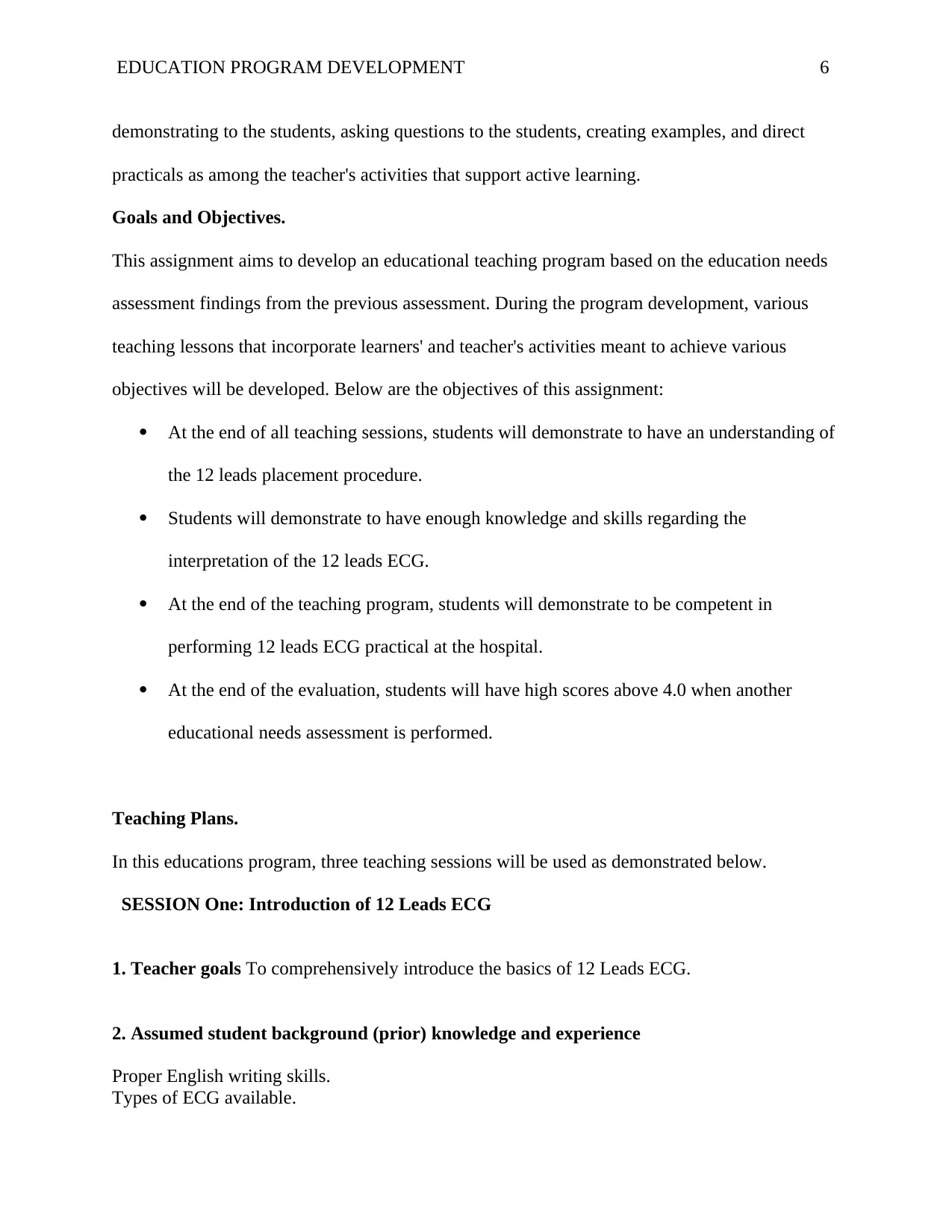
EDUCATION PROGRAM DEVELOPMENT 6
demonstrating to the students, asking questions to the students, creating examples, and direct
practicals as among the teacher's activities that support active learning.
Goals and Objectives.
This assignment aims to develop an educational teaching program based on the education needs
assessment findings from the previous assessment. During the program development, various
teaching lessons that incorporate learners' and teacher's activities meant to achieve various
objectives will be developed. Below are the objectives of this assignment:
At the end of all teaching sessions, students will demonstrate to have an understanding of
the 12 leads placement procedure.
Students will demonstrate to have enough knowledge and skills regarding the
interpretation of the 12 leads ECG.
At the end of the teaching program, students will demonstrate to be competent in
performing 12 leads ECG practical at the hospital.
At the end of the evaluation, students will have high scores above 4.0 when another
educational needs assessment is performed.
Teaching Plans.
In this educations program, three teaching sessions will be used as demonstrated below.
SESSION One: Introduction of 12 Leads ECG
1. Teacher goals To comprehensively introduce the basics of 12 Leads ECG.
2. Assumed student background (prior) knowledge and experience
Proper English writing skills.
Types of ECG available.
demonstrating to the students, asking questions to the students, creating examples, and direct
practicals as among the teacher's activities that support active learning.
Goals and Objectives.
This assignment aims to develop an educational teaching program based on the education needs
assessment findings from the previous assessment. During the program development, various
teaching lessons that incorporate learners' and teacher's activities meant to achieve various
objectives will be developed. Below are the objectives of this assignment:
At the end of all teaching sessions, students will demonstrate to have an understanding of
the 12 leads placement procedure.
Students will demonstrate to have enough knowledge and skills regarding the
interpretation of the 12 leads ECG.
At the end of the teaching program, students will demonstrate to be competent in
performing 12 leads ECG practical at the hospital.
At the end of the evaluation, students will have high scores above 4.0 when another
educational needs assessment is performed.
Teaching Plans.
In this educations program, three teaching sessions will be used as demonstrated below.
SESSION One: Introduction of 12 Leads ECG
1. Teacher goals To comprehensively introduce the basics of 12 Leads ECG.
2. Assumed student background (prior) knowledge and experience
Proper English writing skills.
Types of ECG available.
⊘ This is a preview!⊘
Do you want full access?
Subscribe today to unlock all pages.

Trusted by 1+ million students worldwide
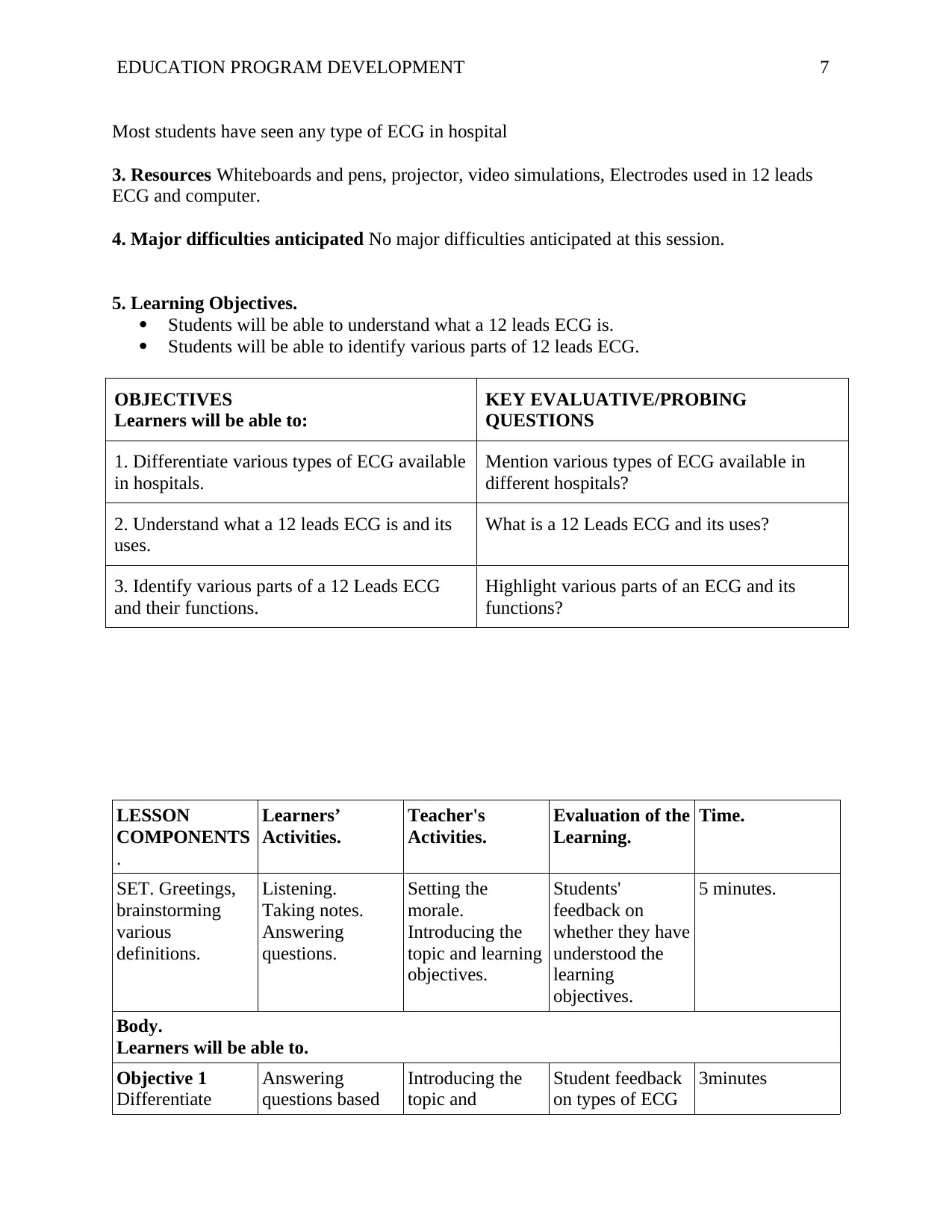
EDUCATION PROGRAM DEVELOPMENT 7
Most students have seen any type of ECG in hospital
3. Resources Whiteboards and pens, projector, video simulations, Electrodes used in 12 leads
ECG and computer.
4. Major difficulties anticipated No major difficulties anticipated at this session.
5. Learning Objectives.
Students will be able to understand what a 12 leads ECG is.
Students will be able to identify various parts of 12 leads ECG.
OBJECTIVES
Learners will be able to:
KEY EVALUATIVE/PROBING
QUESTIONS
1. Differentiate various types of ECG available
in hospitals.
Mention various types of ECG available in
different hospitals?
2. Understand what a 12 leads ECG is and its
uses.
What is a 12 Leads ECG and its uses?
3. Identify various parts of a 12 Leads ECG
and their functions.
Highlight various parts of an ECG and its
functions?
LESSON
COMPONENTS
.
Learners’
Activities.
Teacher's
Activities.
Evaluation of the
Learning.
Time.
SET. Greetings,
brainstorming
various
definitions.
Listening.
Taking notes.
Answering
questions.
Setting the
morale.
Introducing the
topic and learning
objectives.
Students'
feedback on
whether they have
understood the
learning
objectives.
5 minutes.
Body.
Learners will be able to.
Objective 1
Differentiate
Answering
questions based
Introducing the
topic and
Student feedback
on types of ECG
3minutes
Most students have seen any type of ECG in hospital
3. Resources Whiteboards and pens, projector, video simulations, Electrodes used in 12 leads
ECG and computer.
4. Major difficulties anticipated No major difficulties anticipated at this session.
5. Learning Objectives.
Students will be able to understand what a 12 leads ECG is.
Students will be able to identify various parts of 12 leads ECG.
OBJECTIVES
Learners will be able to:
KEY EVALUATIVE/PROBING
QUESTIONS
1. Differentiate various types of ECG available
in hospitals.
Mention various types of ECG available in
different hospitals?
2. Understand what a 12 leads ECG is and its
uses.
What is a 12 Leads ECG and its uses?
3. Identify various parts of a 12 Leads ECG
and their functions.
Highlight various parts of an ECG and its
functions?
LESSON
COMPONENTS
.
Learners’
Activities.
Teacher's
Activities.
Evaluation of the
Learning.
Time.
SET. Greetings,
brainstorming
various
definitions.
Listening.
Taking notes.
Answering
questions.
Setting the
morale.
Introducing the
topic and learning
objectives.
Students'
feedback on
whether they have
understood the
learning
objectives.
5 minutes.
Body.
Learners will be able to.
Objective 1
Differentiate
Answering
questions based
Introducing the
topic and
Student feedback
on types of ECG
3minutes
Paraphrase This Document
Need a fresh take? Get an instant paraphrase of this document with our AI Paraphraser

EDUCATION PROGRAM DEVELOPMENT 8
various types of
ECG available in
hospitals.
on personal
objectives.
Taking Notes.
Listening.
Asking any
relevant
questions.
definition of key
terms.
Demonstrating
various types of
ECG using
presentation.
Clarifying what a
12 leads ECG is.
Answering
questions.
available.
Objective 2
Understand what
a 12 ECG is and
its Uses.
Students feedback
demonstrate a
good
understanding of
a 12 Leads ECG
and its uses
2minutes
Objective 3
Identify various
parts of a 12 leads
ECG.
Watch a video
demonstrating
various parts of a
12 Leads ECG.
Practically
identifying and
familiarizing with
a 12 leads ECG
using small focus
group
discussions.
Introducing a
video with 12
leads ECG.
Arranging the
students into
small groups and
checking whether
they can identify
various parts of a
112 leads ECG
Students can
identify various
electrodes.
10minutes.
Objective 4
State the
functions of
various parts of
ECG.
Taking notes.
Answering
questions.
Group discussion.
Lecturing using
powerpoint
presentation and
video.
Asking questions.
Feedback from
students
demonstrates an
understanding of
the functions of
the ECG.
10minutes.
Closure.
Students demonstrate to have an understanding of the topics and learning objectives.
SESSION TWO: 12 Leads Electrode Placement
1. Teacher goals
At the end of the teaching session, students will demonstrate the knowledge and skills required
for 12 leads electrode placement.
2. Assumed student background (prior) knowledge and experience
Types of ECG.
Understanding what a 12 leads ECG is.
Various parts and functions of a 12 lead ECG.
various types of
ECG available in
hospitals.
on personal
objectives.
Taking Notes.
Listening.
Asking any
relevant
questions.
definition of key
terms.
Demonstrating
various types of
ECG using
presentation.
Clarifying what a
12 leads ECG is.
Answering
questions.
available.
Objective 2
Understand what
a 12 ECG is and
its Uses.
Students feedback
demonstrate a
good
understanding of
a 12 Leads ECG
and its uses
2minutes
Objective 3
Identify various
parts of a 12 leads
ECG.
Watch a video
demonstrating
various parts of a
12 Leads ECG.
Practically
identifying and
familiarizing with
a 12 leads ECG
using small focus
group
discussions.
Introducing a
video with 12
leads ECG.
Arranging the
students into
small groups and
checking whether
they can identify
various parts of a
112 leads ECG
Students can
identify various
electrodes.
10minutes.
Objective 4
State the
functions of
various parts of
ECG.
Taking notes.
Answering
questions.
Group discussion.
Lecturing using
powerpoint
presentation and
video.
Asking questions.
Feedback from
students
demonstrates an
understanding of
the functions of
the ECG.
10minutes.
Closure.
Students demonstrate to have an understanding of the topics and learning objectives.
SESSION TWO: 12 Leads Electrode Placement
1. Teacher goals
At the end of the teaching session, students will demonstrate the knowledge and skills required
for 12 leads electrode placement.
2. Assumed student background (prior) knowledge and experience
Types of ECG.
Understanding what a 12 leads ECG is.
Various parts and functions of a 12 lead ECG.

EDUCATION PROGRAM DEVELOPMENT 9
3. Resources Powerpoint presentation, Video simulation, maker boards, and pen, computer, 12
lead ECGs electrodes, and monitor.
4. Major difficulties anticipated
The procedure of placing 12 leads ECG in specific parts.
Understanding of human anatomy and physiology required during the teaching session.
5. Learning Objectives.
Students will be able to understand the blood supply of the heart.
At the end of the teaching session, students will demonstrate having knowledge and skills
related to 12 leads ECG electrodes placement.
OBJECTIVES
Learners will be able to:
KEY EVALUATIVE/PROBING
QUESTIONS
1. Understand the blood supply of the heart. What are various major arteries and veins
that supply the heart with blood?
2. Perform and demonstrate an understanding of
12 leads ECG electrodes placement.
What is the procedure of placing the 12 leads
ECG electrodes on the human body?
3. Understand the anatomy and physiology
behind locations electrodes are placed
What are the anatomical and physiological
reasons for locations 12 leads ECG
electrodes are placed?
LESSON
COMPONENTS
.
Learners’
Activities.
Teacher's
Activities.
Evaluation of the
Learning.
Time.
SET. Greetings,
brainstorming
various
definitions.
Recap the
previous study.
Listening.
Taking notes.
Answering
questions.
Setting the
morale.
Introducing the
topic and learning
objectives.
Students'
feedback on
whether they have
understood the
learning
objectives.
5 minutes.
Body.
Learners will be able to.
Objective 1
Demonstrate an
understanding of
human anatomy
and physiology of
Group
discussions.
Answering
questions.
Taking notes.
Coordinating
students groups
discussion.
Asking questions.
Lecturing.
Students can
demonstrate an
understanding of
human anatomy
and physiology.
15 minutes
3. Resources Powerpoint presentation, Video simulation, maker boards, and pen, computer, 12
lead ECGs electrodes, and monitor.
4. Major difficulties anticipated
The procedure of placing 12 leads ECG in specific parts.
Understanding of human anatomy and physiology required during the teaching session.
5. Learning Objectives.
Students will be able to understand the blood supply of the heart.
At the end of the teaching session, students will demonstrate having knowledge and skills
related to 12 leads ECG electrodes placement.
OBJECTIVES
Learners will be able to:
KEY EVALUATIVE/PROBING
QUESTIONS
1. Understand the blood supply of the heart. What are various major arteries and veins
that supply the heart with blood?
2. Perform and demonstrate an understanding of
12 leads ECG electrodes placement.
What is the procedure of placing the 12 leads
ECG electrodes on the human body?
3. Understand the anatomy and physiology
behind locations electrodes are placed
What are the anatomical and physiological
reasons for locations 12 leads ECG
electrodes are placed?
LESSON
COMPONENTS
.
Learners’
Activities.
Teacher's
Activities.
Evaluation of the
Learning.
Time.
SET. Greetings,
brainstorming
various
definitions.
Recap the
previous study.
Listening.
Taking notes.
Answering
questions.
Setting the
morale.
Introducing the
topic and learning
objectives.
Students'
feedback on
whether they have
understood the
learning
objectives.
5 minutes.
Body.
Learners will be able to.
Objective 1
Demonstrate an
understanding of
human anatomy
and physiology of
Group
discussions.
Answering
questions.
Taking notes.
Coordinating
students groups
discussion.
Asking questions.
Lecturing.
Students can
demonstrate an
understanding of
human anatomy
and physiology.
15 minutes
⊘ This is a preview!⊘
Do you want full access?
Subscribe today to unlock all pages.

Trusted by 1+ million students worldwide
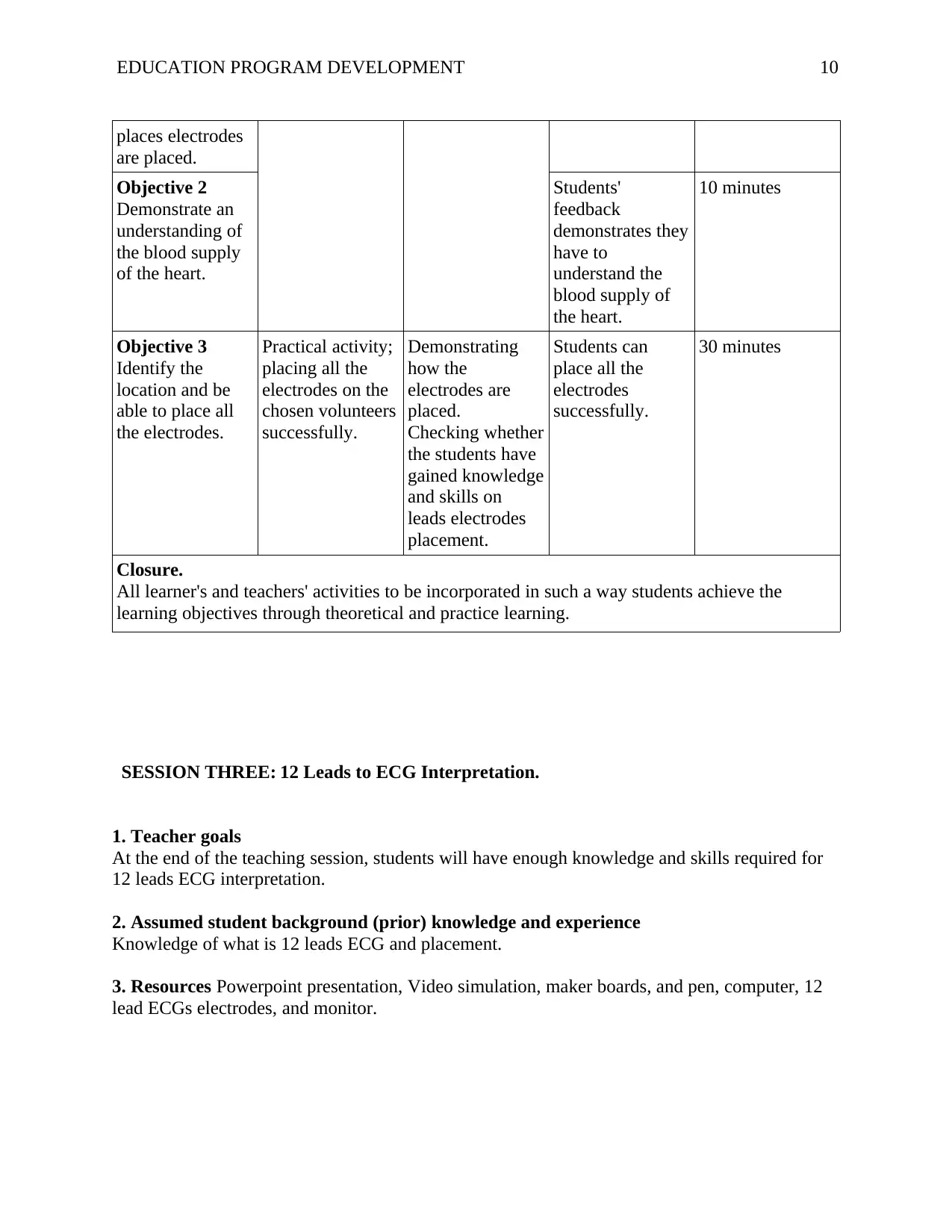
EDUCATION PROGRAM DEVELOPMENT 10
places electrodes
are placed.
Objective 2
Demonstrate an
understanding of
the blood supply
of the heart.
Students'
feedback
demonstrates they
have to
understand the
blood supply of
the heart.
10 minutes
Objective 3
Identify the
location and be
able to place all
the electrodes.
Practical activity;
placing all the
electrodes on the
chosen volunteers
successfully.
Demonstrating
how the
electrodes are
placed.
Checking whether
the students have
gained knowledge
and skills on
leads electrodes
placement.
Students can
place all the
electrodes
successfully.
30 minutes
Closure.
All learner's and teachers' activities to be incorporated in such a way students achieve the
learning objectives through theoretical and practice learning.
SESSION THREE: 12 Leads to ECG Interpretation.
1. Teacher goals
At the end of the teaching session, students will have enough knowledge and skills required for
12 leads ECG interpretation.
2. Assumed student background (prior) knowledge and experience
Knowledge of what is 12 leads ECG and placement.
3. Resources Powerpoint presentation, Video simulation, maker boards, and pen, computer, 12
lead ECGs electrodes, and monitor.
places electrodes
are placed.
Objective 2
Demonstrate an
understanding of
the blood supply
of the heart.
Students'
feedback
demonstrates they
have to
understand the
blood supply of
the heart.
10 minutes
Objective 3
Identify the
location and be
able to place all
the electrodes.
Practical activity;
placing all the
electrodes on the
chosen volunteers
successfully.
Demonstrating
how the
electrodes are
placed.
Checking whether
the students have
gained knowledge
and skills on
leads electrodes
placement.
Students can
place all the
electrodes
successfully.
30 minutes
Closure.
All learner's and teachers' activities to be incorporated in such a way students achieve the
learning objectives through theoretical and practice learning.
SESSION THREE: 12 Leads to ECG Interpretation.
1. Teacher goals
At the end of the teaching session, students will have enough knowledge and skills required for
12 leads ECG interpretation.
2. Assumed student background (prior) knowledge and experience
Knowledge of what is 12 leads ECG and placement.
3. Resources Powerpoint presentation, Video simulation, maker boards, and pen, computer, 12
lead ECGs electrodes, and monitor.
Paraphrase This Document
Need a fresh take? Get an instant paraphrase of this document with our AI Paraphraser

EDUCATION PROGRAM DEVELOPMENT 11
4. Major difficulties anticipated.
Interpretation of various ECGs pictures.
6. Learning Objectives.
To identify a normal ECG sheet.
To differentiate various types of abnormalities identified by a 12 leads ECG.
OBJECTIVES
Learners will be able to:
KEY EVALUATIVE/PROBING
QUESTIONS
1. Identify normal pattern ECG waves on the
monitor.
How does a normal pattern of a 12 ECG leads
wave look like?
2. Interpret and identify abnormal 12 Leads
ECG waves
How do the other 12 leads ECG waves mean?
LESSON
COMPONENTS
.
Learners’
Activities.
Teacher's
Activities.
Evaluation of the
Learning.
Time.
SET. Greetings,
brainstorming
various
definitions.
Recap of the
previous sessions.
Listening.
Taking notes.
Answering
questions.
Setting the
morale.
Introducing the
topic and learning
objectives.
Students'
feedback on
whether they have
understood the
learning
objectives.
5 minutes.
Body.
The learners will be able to.
Objective 1
Place and
interpret a normal
12 Lead ECG
wave.
Group discussion.
Practical activity;
placing and
interpreting a
normal ECG
wave.
Taking notes.
Coordinating
students with
group discussion
and practical
activity.
Interpreting
normal ECG
curves.
Lecturing.
Students
demonstrate to
have gain
knowledge and
skills in placing
electrodes and
interpreting a
normal ECG
wave.
30minutes
Objective 2
Interpret or be
able to identify an
Group
Discussion.
Leaning and
Coordinating
group
discussions.
Students have
demonstrated to
differentiate
15minutes
4. Major difficulties anticipated.
Interpretation of various ECGs pictures.
6. Learning Objectives.
To identify a normal ECG sheet.
To differentiate various types of abnormalities identified by a 12 leads ECG.
OBJECTIVES
Learners will be able to:
KEY EVALUATIVE/PROBING
QUESTIONS
1. Identify normal pattern ECG waves on the
monitor.
How does a normal pattern of a 12 ECG leads
wave look like?
2. Interpret and identify abnormal 12 Leads
ECG waves
How do the other 12 leads ECG waves mean?
LESSON
COMPONENTS
.
Learners’
Activities.
Teacher's
Activities.
Evaluation of the
Learning.
Time.
SET. Greetings,
brainstorming
various
definitions.
Recap of the
previous sessions.
Listening.
Taking notes.
Answering
questions.
Setting the
morale.
Introducing the
topic and learning
objectives.
Students'
feedback on
whether they have
understood the
learning
objectives.
5 minutes.
Body.
The learners will be able to.
Objective 1
Place and
interpret a normal
12 Lead ECG
wave.
Group discussion.
Practical activity;
placing and
interpreting a
normal ECG
wave.
Taking notes.
Coordinating
students with
group discussion
and practical
activity.
Interpreting
normal ECG
curves.
Lecturing.
Students
demonstrate to
have gain
knowledge and
skills in placing
electrodes and
interpreting a
normal ECG
wave.
30minutes
Objective 2
Interpret or be
able to identify an
Group
Discussion.
Leaning and
Coordinating
group
discussions.
Students have
demonstrated to
differentiate
15minutes
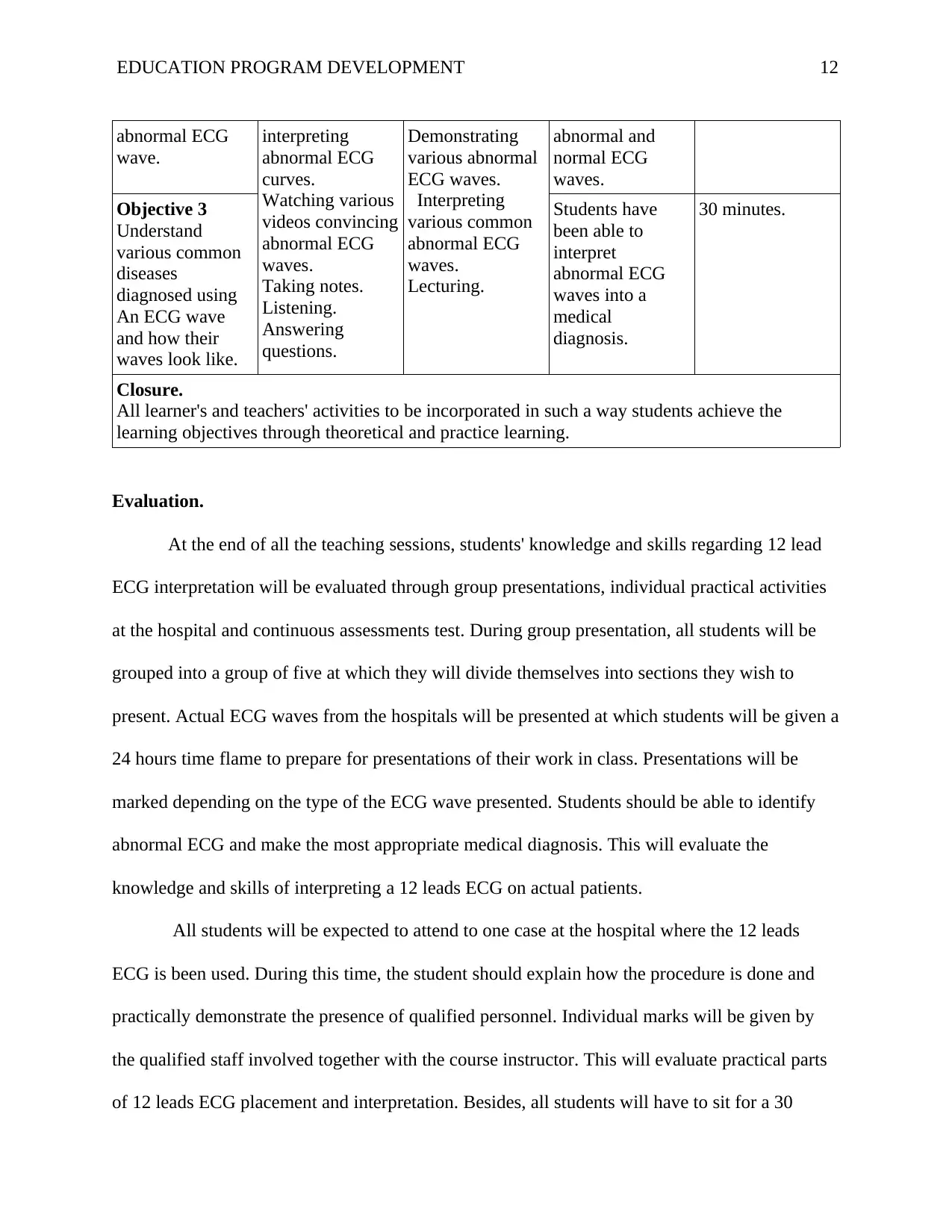
EDUCATION PROGRAM DEVELOPMENT 12
abnormal ECG
wave.
interpreting
abnormal ECG
curves.
Watching various
videos convincing
abnormal ECG
waves.
Taking notes.
Listening.
Answering
questions.
Demonstrating
various abnormal
ECG waves.
Interpreting
various common
abnormal ECG
waves.
Lecturing.
abnormal and
normal ECG
waves.
Objective 3
Understand
various common
diseases
diagnosed using
An ECG wave
and how their
waves look like.
Students have
been able to
interpret
abnormal ECG
waves into a
medical
diagnosis.
30 minutes.
Closure.
All learner's and teachers' activities to be incorporated in such a way students achieve the
learning objectives through theoretical and practice learning.
Evaluation.
At the end of all the teaching sessions, students' knowledge and skills regarding 12 lead
ECG interpretation will be evaluated through group presentations, individual practical activities
at the hospital and continuous assessments test. During group presentation, all students will be
grouped into a group of five at which they will divide themselves into sections they wish to
present. Actual ECG waves from the hospitals will be presented at which students will be given a
24 hours time flame to prepare for presentations of their work in class. Presentations will be
marked depending on the type of the ECG wave presented. Students should be able to identify
abnormal ECG and make the most appropriate medical diagnosis. This will evaluate the
knowledge and skills of interpreting a 12 leads ECG on actual patients.
All students will be expected to attend to one case at the hospital where the 12 leads
ECG is been used. During this time, the student should explain how the procedure is done and
practically demonstrate the presence of qualified personnel. Individual marks will be given by
the qualified staff involved together with the course instructor. This will evaluate practical parts
of 12 leads ECG placement and interpretation. Besides, all students will have to sit for a 30
abnormal ECG
wave.
interpreting
abnormal ECG
curves.
Watching various
videos convincing
abnormal ECG
waves.
Taking notes.
Listening.
Answering
questions.
Demonstrating
various abnormal
ECG waves.
Interpreting
various common
abnormal ECG
waves.
Lecturing.
abnormal and
normal ECG
waves.
Objective 3
Understand
various common
diseases
diagnosed using
An ECG wave
and how their
waves look like.
Students have
been able to
interpret
abnormal ECG
waves into a
medical
diagnosis.
30 minutes.
Closure.
All learner's and teachers' activities to be incorporated in such a way students achieve the
learning objectives through theoretical and practice learning.
Evaluation.
At the end of all the teaching sessions, students' knowledge and skills regarding 12 lead
ECG interpretation will be evaluated through group presentations, individual practical activities
at the hospital and continuous assessments test. During group presentation, all students will be
grouped into a group of five at which they will divide themselves into sections they wish to
present. Actual ECG waves from the hospitals will be presented at which students will be given a
24 hours time flame to prepare for presentations of their work in class. Presentations will be
marked depending on the type of the ECG wave presented. Students should be able to identify
abnormal ECG and make the most appropriate medical diagnosis. This will evaluate the
knowledge and skills of interpreting a 12 leads ECG on actual patients.
All students will be expected to attend to one case at the hospital where the 12 leads
ECG is been used. During this time, the student should explain how the procedure is done and
practically demonstrate the presence of qualified personnel. Individual marks will be given by
the qualified staff involved together with the course instructor. This will evaluate practical parts
of 12 leads ECG placement and interpretation. Besides, all students will have to sit for a 30
⊘ This is a preview!⊘
Do you want full access?
Subscribe today to unlock all pages.

Trusted by 1+ million students worldwide
1 out of 17
Your All-in-One AI-Powered Toolkit for Academic Success.
+13062052269
info@desklib.com
Available 24*7 on WhatsApp / Email
![[object Object]](/_next/static/media/star-bottom.7253800d.svg)
Unlock your academic potential
Copyright © 2020–2025 A2Z Services. All Rights Reserved. Developed and managed by ZUCOL.

